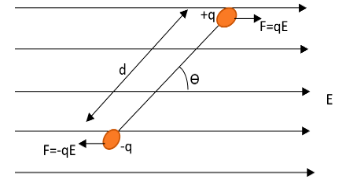Question
Question: Electric potential energy of an Electric dipole in dipole from zero energy position to a particular ...
Electric potential energy of an Electric dipole in dipole from zero energy position to a particular position (The zero energy position to be one when an electric dipole of dipole moment p is on it such that
P=p×E
This torque will tend to rotate the dipole. Let dW be the small amount of work done. This will turn the dipole through an angle dθ. That is,
dW=Text⋅dθ⇒dW=pEsinθdθ
Let W be the work done in turning the dipole from 0∘ to θ∘ then,
Solution
potential energy is the energy required by the body in order to take it from the infinity to a specific position according to our need. Torque is the rotational analogue for the force in mechanics. It is the force required for the body in order to rotate in a specific way. This all will help you in answering this question.
Complete answer:
The force experienced by the charges can be shown as qE and −qE , as represented in the diagram.
τ=p×E
The measure of work done by the external torque can be shown as,
W=θ0∫θ1τext(θ)dθ
Substituting the value of the torque in this will give,
The measure of work done by the external torque can be shown as,
W=θ0∫θ1pEsinθdθ=pE(cosθ0−cosθ1)
As we all know that the work done in taking a system of charges from infinity to a specific configuration is explained as the potential energy of the system. That is the potential energy of the system can be shown as,
U(θ)=pE(cosθ0−cosθ1)

Note:
The electric potential and potential energy are not the same. The major difference is that electric potential at a position in an electric field is the measure of work done to take the unit positive charge from infinity to that position. The electric potential energy is defined as the energy that is required to move a charge against the electric field.
